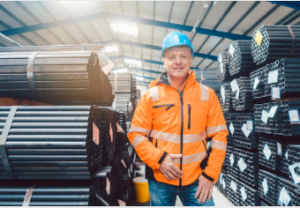Updated on December 11, 2023
Types of Steel
There are many types of steel. These types include Low carbon steel, alloy steel, High-speed steel, and shock-resistant steel. Engineers use different methods to produce different types of steel, including cold forming, hot rolling, and heat-treating. Those processes result in a variety of steel properties and microstructures.
Alloy steels
 Alloy steels are mixed with one or more elements in total amounts ranging from 1.0% to 50% by weight to give them better mechanical properties. They can be broken down into two categories: low alloy steels and high alloy steels. However, the distinction between these two groups is often disputed.
Alloy steels are mixed with one or more elements in total amounts ranging from 1.0% to 50% by weight to give them better mechanical properties. They can be broken down into two categories: low alloy steels and high alloy steels. However, the distinction between these two groups is often disputed.
The most common uses of alloy steels are in constructions. They are used for many construction projects, from building structures to automotive skeletons. They also serve as reinforcement in concrete structures, helping them weigh less overall. Some examples of construction products include plates, sheets, and rods. Stainless steels are also used in the production of sockets and other fixtures.
Another type of steel Adelaide is called alloy tool steel. These are used in high-quality drills and reamers. They also have good corrosion resistance and weldability. They are also commonly used in plastic moulds and punch press tooling.
Low-carbon steels
Low-carbon steels are those that contain a low percentage of carbon. They are used in many applications, such as structural shapes and automobile body components. Low-carbon steels are also popular in the manufacture of food cans and pipes. These materials are also very ductile and weldable. In addition, low-carbon steels are inexpensive to produce compared to other types of steel. Medium-carbon steels contain between 0.25% and 0.60% of carbon. This type of steel can be heat treated, tempered, and quenched, giving it superior toughness.
Low-carbon steels are typically galvanised, which means they are coated with zinc. There are different galvanised steels, each with a different amount of zinc. Some steels are coated with a thin layer of zinc, while others are coated with multiple layers of zinc. Zinc is typically applied at the coil coater to achieve the desired thickness. The thickness of the zinc layer does not affect the gauge. Coating weights are measured in grams per square meter. For example, a 60G/60G coating will contain 60 grams per square meter.
Low-carbon steels are used in many applications, such as in the heavy machinery industry. They have low costs and are easy to manufacture. In addition, they have many uses in our everyday lives. Some of these applications include building frames. They can withstand high-impact, wind, and seismic loads, making them a desirable choice for many construction projects.
High-speed steel
High-speed steel Adelaide is a type of tool steel that’s commonly used in cutting tools. This material is highly ductile and offers high levels of hardness and toughness, making it a popular choice for toolmakers. Although it has several applications, its primary function is as a cutting tool material.
The high hardness of high-speed steel results from its martensitic structure. It occurs during the process of austenising to near-melting temperatures and multiple tempering cycles. As a result, high-speed steel develops high quantities of complex metallic carbides, which result in increased hardness and wear resistance.
High-speed steel is often referred to as Dura-Steel. This material has a darker hue than regular steel and looks similar to a polymer. It is made in a blast furnace by combining standard steel with Tungsten. The resulting material is a much more advanced standard steel version.
Shock-resisting steel
Shock-resistant steels are used in a variety of applications. For example, shock-resistant steels are used to create punches and dies, which regularly go through high pressure and shock. Shock-resistant steel is also used to produce springs. Although these materials are often used for the same applications, they have different properties.
While they can be pretty expensive, nickel alloys are sometimes used to make shock-resistant steels. For instance, Swedish saw steel is made from nickel alloys. These nickel alloys are also used in manufacturing jackhammer bits. This alloy can be 1.75% or 2.75% nickel. Despite the high cost, it is used to produce jackhammer bits.
The yield strength of a material determines its ability to withstand a certain amount of force without plastic deformation or failure. Therefore, the relationship between external loads, material deformation, and material dimensions is considered when determining a material’s yield strength. For example, shock-resistant steels typically have a tensile strength of around 1800 MPa.
